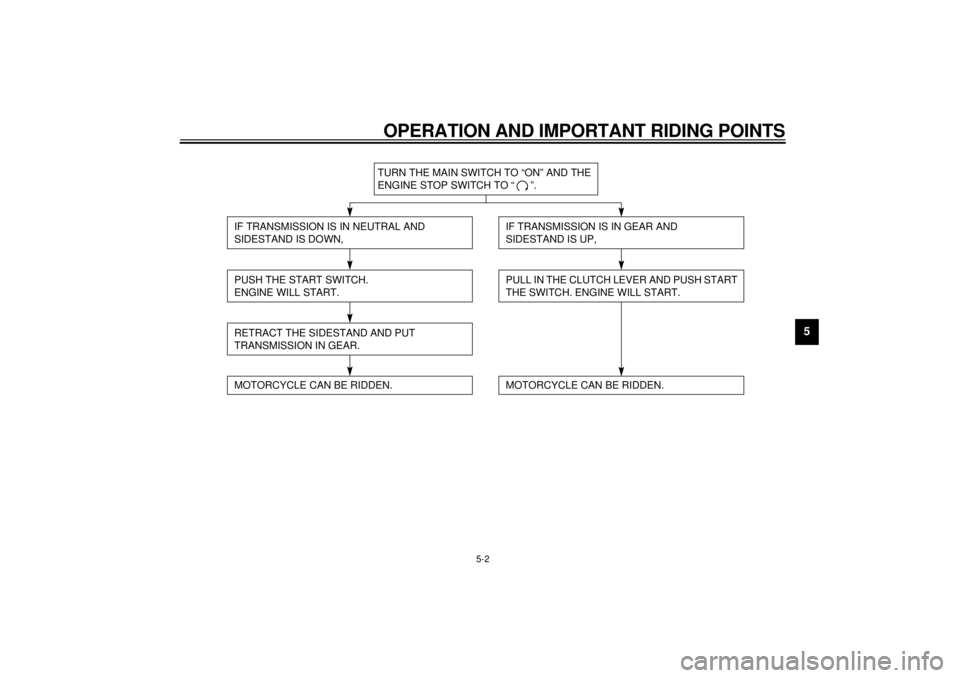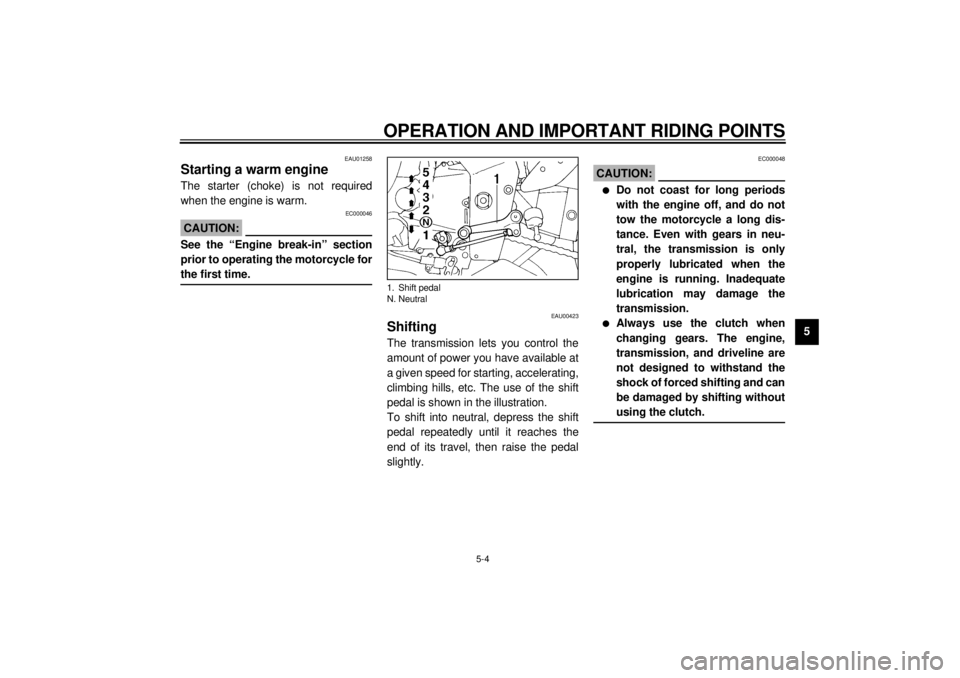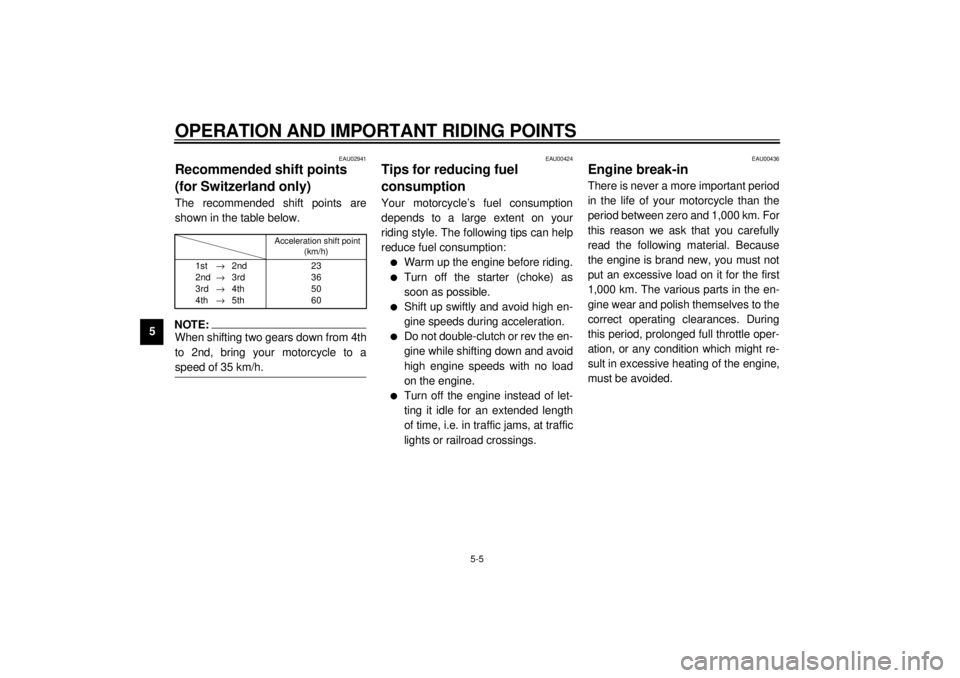2000 YAMAHA YZF1000 clutch
[x] Cancel search: clutchPage 41 of 103

5-1
5
EAU00372
5-OPERATION AND IMPORTANT RIDING POINTS
EAU00373
WARNING
@ l
Before riding this motorcycle,
become thoroughly familiar
with all operating controls and
their functions. Consult a
Yamaha dealer regarding any
control or function that you do
not thoroughly understand.
l
Never start your engine or let it
run for any length of time in a
closed area. The exhaust fumes
are poisonous and can cause
loss of consciousness and
death within a short time. Al-
ways operate your motorcycle
in an area with adequate ventila-
tion.
l
Before starting out, always be
sure the sidestand is up. Failure
to retract the sidestand com-
pletely can result in a serious
accident when you try to turn a
corner.
@
EAU01627
Starting the engineNOTE:@ This motorcycle is equipped with an ig-
nition circuit cut-off system.
The engine can be started only under
one of the following conditions:l
The transmission is in neutral.
l
The sidestand is up, the transmis-
sion is in gear and the clutch is dis-
engaged.
The motorcycle must not be ridden
when the sidestand is down.
@
EW000054
WARNING
@ Before going through the following
steps, check the function of the
sidestand switch and clutch switch.
(Refer to page 3-20.) @
E_4sv_Operation.fm Page 1 Tuesday, August 31, 1999 3:45 PM
Page 42 of 103

OPERATION AND IMPORTANT RIDING POINTS
5-2
5
CF-28E
TURN THE MAIN SWITCH TO “ON” AND THE
ENGINE STOP SWITCH TO “ ”.
IF TRANSMISSION IS IN NEUTRAL AND
SIDESTAND IS DOWN,PUSH THE START SWITCH.
ENGINE WILL START.RETRACT THE SIDESTAND AND PUT
TRANSMISSION IN GEAR.
IF TRANSMISSION IS IN GEAR AND
SIDESTAND IS UP,PULL IN THE CLUTCH LEVER AND PUSH START
THE SWITCH. ENGINE WILL START.
MOTORCYCLE CAN BE RIDDEN.
MOTORCYCLE CAN BE RIDDEN.
E_4sv_Operation.fm Page 2 Tuesday, August 31, 1999 3:45 PM
Page 44 of 103

OPERATION AND IMPORTANT RIDING POINTS
5-4
5
EAU01258
Starting a warm engineThe starter (choke) is not required
when the engine is warm.
EC000046
CAUTION:@ See the “Engine break-in” section
prior to operating the motorcycle for
the first time. @
EAU00423
ShiftingThe transmission lets you control the
amount of power you have available at
a given speed for starting, accelerating,
climbing hills, etc. The use of the shift
pedal is shown in the illustration.
To shift into neutral, depress the shift
pedal repeatedly until it reaches the
end of its travel, then raise the pedal
slightly.
EC000048
CAUTION:@ l
Do not coast for long periods
with the engine off, and do not
tow the motorcycle a long dis-
tance. Even with gears in neu-
tral, the transmission is only
properly lubricated when the
engine is running. Inadequate
lubrication may damage the
transmission.
l
Always use the clutch when
changing gears. The engine,
transmission, and driveline are
not designed to withstand the
shock of forced shifting and can
be damaged by shifting without
using the clutch.
@
1. Shift pedal
N. Neutral
E_4sv_Operation.fm Page 4 Tuesday, August 31, 1999 3:45 PM
Page 45 of 103

OPERATION AND IMPORTANT RIDING POINTS
5-5
5
EAU02941
Recommended shift points
(for Switzerland only)The recommended shift points are
shown in the table below.CF-25ENOTE:@ When shifting two gears down from 4th
to 2nd, bring your motorcycle to a
speed of 35 km/h. @
EAU00424
Tips for reducing fuel
consumptionYour motorcycle’s fuel consumption
depends to a large extent on your
riding style. The following tips can help
reduce fuel consumption:l
Warm up the engine before riding.
l
Turn off the starter (choke) as
soon as possible.
l
Shift up swiftly and avoid high en-
gine speeds during acceleration.
l
Do not double-clutch or rev the en-
gine while shifting down and avoid
high engine speeds with no load
on the engine.
l
Turn off the engine instead of let-
ting it idle for an extended length
of time, i.e. in traffic jams, at traffic
lights or railroad crossings.
EAU00436
Engine break-inThere is never a more important period
in the life of your motorcycle than the
period between zero and 1,000 km. For
this reason we ask that you carefully
read the following material. Because
the engine is brand new, you must not
put an excessive load on it for the first
1,000 km. The various parts in the en-
gine wear and polish themselves to the
correct operating clearances. During
this period, prolonged full throttle oper-
ation, or any condition which might re-
sult in excessive heating of the engine,
must be avoided.
Acceleration shift point
(km/h)
1st®2nd
2nd®3rd
3rd®4th
4th®5th23
36
50
60
E_4sv_Operation.fm Page 5 Tuesday, August 31, 1999 3:45 PM
Page 48 of 103

6
PERIODIC MAINTENANCE AND MINOR REPAIR
Tool kit................................................................... 6-1
Periodic maintenance and lubrication ................... 6-2
Cowling removal and installation .......................... 6-5
Cowling A.............................................................. 6-5
Cowling B.............................................................. 6-5
Cowling C ............................................................. 6-6
Spark plugs........................................................... 6-7
Engine oil .............................................................. 6-9
Coolant ............................................................... 6-11
Air filter ............................................................... 6-12
Carburetor adjustment ........................................ 6-14
Idle speed adjustment ........................................ 6-15
Throttle cable free play inspection ...................... 6-15
Valve clearance adjustment ................................ 6-16
Tires .................................................................... 6-16
Wheels................................................................ 6-19
Brake light switch adjustment ............................. 6-19
Checking the front and rear brake pads.............. 6-20
Inspecting the brake fluid level............................ 6-21
Brake fluid replacement ...................................... 6-22
Drive chain slack check ...................................... 6-23Drive chain slack adjustment ............................. 6-23
Drive chain lubrication........................................ 6-24
Cable inspection and lubrication ........................ 6-24
Brake and shift pedal lubrication ........................ 6-24
Brake and clutch lever lubrication ...................... 6-25
Sidestand lubrication.......................................... 6-25
Rear suspension lubrication............................... 6-25
Front fork inspection ........................................... 6-26
Steering inspection ............................................ 6-26
Wheel bearings .................................................. 6-27
Battery................................................................ 6-27
Fuse replacement .............................................. 6-28
Headlight bulb replacement ............................... 6-29
Tail/brake light bulb replacement ........................ 6-30
Turn signal light bulb replacement...................... 6-30
Front wheel removal ........................................... 6-31
Front wheel installation ...................................... 6-31
Rear wheel removal ........................................... 6-32
Rear wheel installation ....................................... 6-33
Troubleshooting .................................................. 6-34
Troubleshooting chart......................................... 6-35
E_4sv_PeriodicTOC.fm Page 1 Tuesday, August 31, 1999 3:45 PM
Page 50 of 103

PERIODIC MAINTENANCE AND MINOR REPAIR
6-2
6
EAU00473
PERIODIC MAINTENANCE AND LUBRICATION
CP-01ENO. ITEM CHECKS AND MAINTENANCE JOBSINITIAL
(1,000 km)EVERY
6,000 km
or
6 months
(whichever
comes first)12,000 km
or
12 months
(whichever
comes first)
1
*Fuel line• Check fuel hoses and vacuum hose for cracks or damage.
• Replace if necessary.ÖÖ
2*Fuel filter• Check condition.
• Replace if necessary.Ö
3 Spark plugs• Check condition.
• Clean, regap or replace if necessary.ÖÖÖ
4*Valves• Check valve clearance.
• Adjust if necessary.Every 42,000 km or 42 months
(whichever comes first)
5 Air filter
• Clean or replace if necessary.ÖÖ
6*Clutch• Check operation, fluid level and vehicle for fluid leakage.
(See NOTE on page 6-4.)
• Correct accordingly. ÖÖÖ
7*Front brake• Check operation, fluid level and vehicle for fluid leakage.
(See NOTE on page 6-4.)
• Correct accordingly.
• Replace brake pads if necessary.ÖÖÖ
8*Rear brake• Check operation, fluid level and vehicle for fluid leakage.
(See NOTE on page 6-4.)
• Correct accordingly.
• Replace brake pads if necessary.ÖÖÖ
9*Wheels• Check balance, runout and for damage.
• Rebalance or replace if necessary.ÖÖ
10*Tires• Check tread depth and for damage.
• Replace if necessary.
• Check air pressure.
• Correct if necessary.ÖÖ
E_4sv_Periodic.fm Page 2 Tuesday, August 31, 1999 3:45 PM
Page 52 of 103

PERIODIC MAINTENANCE AND MINOR REPAIR
6-4
6
* Since these items require special tools, data and technical skills, they should be serviced by a Yamaha dealer.
EAU02971*
NOTE:@ l
The air filter needs more frequent service if you are riding in unusually wet or dusty areas.
l
Hydraulic brake and clutch systems
• After disassembling the master cylinder, caliper cylinder or clutch release cylinder, always replace the brake fluid.
Check the brake fluid level of the master cylinder and clutch release cylinder regularly and fill as required.
• Replace the oil seals on the inner parts of the master cylinder, caliper cylinder and clutch release cylinder every two
years.
• Replace the brake and clutch hoses every four years or if cracked or damaged.
@22 Engine oil• Check oil level and vehicle for oil leakage.
• Correct if necessary.
• Change. (Warm engine before draining.)ÖÖÖ
23 Engine oil filter cartridge
• Replace.ÖÖ
24
*Cooling system• Check coolant level and vehicle for coolant leakage.
• Correct if necessary.
• Change coolant every 24,000 km or 24 months
(whichever comes first).ÖÖ NO. ITEM CHECKS AND MAINTENANCE JOBSINITIAL
(1,000 km)EVERY
6,000 km
or
6 months
(whichever
comes first)12,000 km
or
12 months
(whichever
comes first)
E_4sv_Periodic.fm Page 4 Tuesday, August 31, 1999 3:45 PM
Page 59 of 103

PERIODIC MAINTENANCE AND MINOR REPAIR
6-11
6
EC000066
CAUTION:@ l
Do not put in any chemical addi-
tives. Engine oil also lubricates
the clutch and additives could
cause clutch slippage.
l
Be sure no foreign material en-
ters the crankcase.
@
10. Start the engine and warm it up for
several minutes. While warming
up, check for oil leakage. If oil
leakage is found, stop the engine
immediately and check for the
cause.NOTE:@ After the engine is started, the oil level
indicator light should go off if the oil is at
the specified level. @
EC000067
CAUTION:@ If the indicator light flickers or re-
mains on, immediately stop the en-
gine and consult with a Yamaha
dealer. @11. Install the cowling stay and cowl-
ing.
EAU01594
CoolantCheck the coolant level in the reservoir
tank when the engine is cold. The cool-
ant level will vary with engine tempera-
ture. The coolant level is satisfactory if
it is between the minimum and maxi-
mum marks on the tank. If the coolant
level is at or below the minimum mark,
fill with tap water (soft water) to bring
the level up to the maximum mark.
Have a Yamaha dealer change the
coolant every two years. Recommended oil:
See page 8-1.
Oil quantity:
Total amount:
3.5 L
Periodic oil change:
3.0 L
With oil filter replacement:
3.2 L1. Maximum level mark
2. Minimum level mark
E_4sv_Periodic.fm Page 11 Tuesday, August 31, 1999 3:45 PM